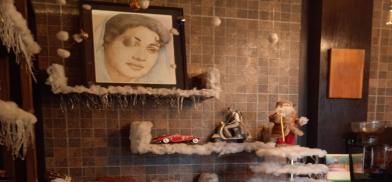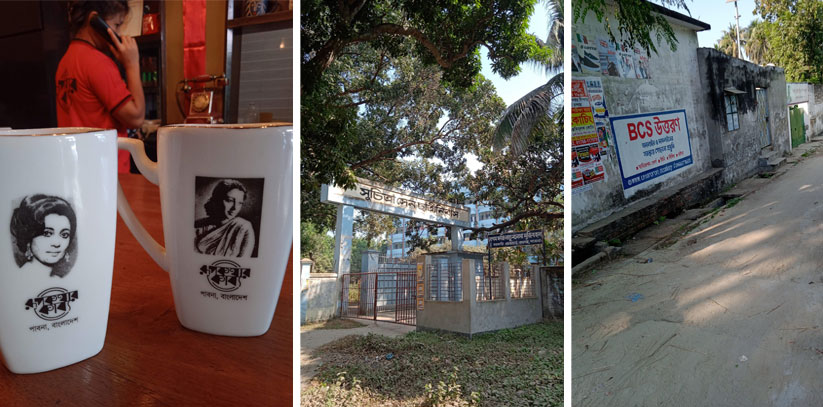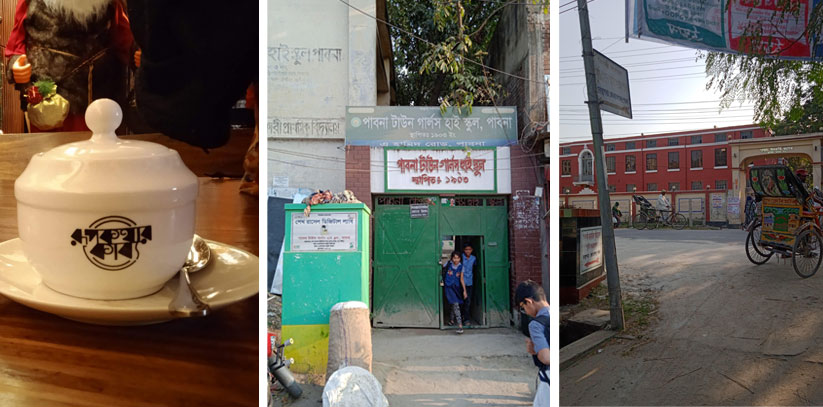Rediscovering Suchitra Sen in Bangladesh: Tracing the portrait of a glamorous actress on an easel of the past
As busy evenings of youngsters flock over to Roopkawthar Kabbo, the narrative of the legend from yesteryears reverberates through each cup served and, for the uninitiated, these cups are the connecting dots of time when an answer comes with the query of “Who is this?”.

One of the leading actors of the Indian film industry, Suchitra Sen, was not only a famous name in Bengali cinema but was a person who left an indelible mark in the field of visual and performing arts of India. She is the first actress from the country to receive an international film award in 1963 at the Moscow International Film Festival. She was awarded the Silver Prize for Best Actress for her performance in the movie ‘Saat Paake Bandha’ (1963). Six decades down the lane and nearly a decade since the actress left us on January 17, 2014, it was a serendipitous experience to discover small folios of Sen’s memory, ensconced within some of the most unexpected places in her birthplace Pabna, in Bangladesh. This is the story of rediscovering the actor in some of the most unusual spaces in Pabna, which still continue to carry forward the legacy of the legendary actress even at present.
On a very recent trip to Pabna in Bangladesh, as I got off the bus, having reached from Dhaka over a four-hour bus ride, followed by a twenty-minute steam-boat ride over the river Jamuna, (otherwise referred to as the Brahmaputra), I reached a cycle-rickshaw stand in Pabna town. A busy place, this is locally famous as the CNG Stand (a terminus for autorickshaws) at present, having an erstwhile name of Ghora Stand. The changeover of the name itself will make one wonder about the necessities of time firmly replacing symbols of the past with victuals of the present. Accompanied by Sohan, a young student in fourth year B.Sc (Mathematics) of the famous Government Edward College, Pabna, I boarded a cycle-rickshaw to set off for my hotel in Pabna Town.
While on my way to the hotel, a sudden reference to a couple of historical sites in Pabna brought up the name of two Bengali personalities from the discipline of performing arts - Manjushree Chaki Sarkar and Suchitra Sen, and I was offered an option if I wanted to see the erstwhile houses of either or both, as these residences stand as each other’s neighbour. The offer immediately fleeted me off through the pages of history as I started to recall various names of Bengali artists who hailed from Bangladesh. I agreed and very shortly, we reached the entrance of a narrow gully on the Pabna-Sujanagar highway.
This narrow gully was right on the opposite side of the road of the Pabna Shilpokola Academy. A prominent signboard stood at the very entrance of the gully, marking a special place. This signboard mentions the gully to house the Suchitra Sen Memorial Museum (Suchitra Sen Jaadughar), in other words, the old residence of Suchitra Sen. A broad, whiteboard, borderlined with blue, announces the exact name of the museum - Kimbadanti Mahanayika Suchitra Sen Smriti Sangrahashala, and under the name is written the authority looking after the place, Jela Prashashon, Pabna. A one-storeyed structure, amidst other similar one or two-storeyed structures next to it, a very brief walk of a few seconds from the signboard, took me to a short wall and an iron gate. The place had a school running on its premises, which led to a court battle. After winning a prolonged legal battle on July 16, 2014, the museum was established on April 6, 2017.

Tracing the past
The gate was shut at the time I approached and I could see a ticket counter on its right. On top of the gate was written a phone number. If one needed to enter, this phone number was to be contacted. Unfortunately, the call did not yield any positive response as it was a Monday, when the museum was kept shut from the public. It was only later that I got informed about the place, which has been organised and arranged with various photographs of the legendary actress, with only a statue of the actress in the front of the house.
These are the only decorations within. The small courtyard inside the iron gates compliments the quaint structure. Above all what strikes one is the simplicity of the entire space, overwhelming one to conjure a humble association with a famous and albeit glamorous actress of the world of Indian cinema. Therein lies the simple paths of history, speaking of niches and corners and about extraordinary yet ordinary things along the way.
Suchitra Sen, originally Roma Dasgupta, was born on April 6, 1931 in Bahanga Bari village of Belkuchi Upazilla of Sirajganj district of Bangladesh. Later, she was raised till her early teens in Pabna, where her father was a headmaster in a local school. However, soon after, in 1947, Sen’s parents and siblings moved to Bengal during the ongoing political convulsions leading up to independence, followed by the partition of India. The same year, in 1947, Suchitra Sen was married to Dibanath Sen, the son of Adinath Sen, whose family were industrialists and also descendants from the royal family of Tripura. Her father-in-law was greatly supportive of her acting career after marriage.
Though she began in 1952 with the film ‘Sesh Kothay’, it never got released. The very next year (1953) saw Sen begin her journey, which lasted for more than twenty years. This happened with ‘Saat Number Koyedi’ by Sukumar Dasgupta, followed by ‘Sharey Chuattor’ by Nirmal Dey, both releasing in the same month of February 1953. ‘Sharey Chuattor’ is also remembered as the beginning of her work as the lead actress opposite Uttam Kumar and she went on to star in 30 movies, out of 60 of her career, as the co-star of Uttam Kumar. Her acting career also included a brief stint with Hindi movies, where she received a Best Actress Nomination at the Filmfare awards for her role in her very first Hindi film ‘Devdas’ in 1955. Thereafter the long journey saw many accolades and many memorable portrayals of several characters, which are still remembered and often mentioned on critic pages by their screen names. In 1972, she won the Padma Shri for notable contributions to arts and a Filmfare East Lifetime Achievement Award (posthumous) in 2014.
Coming back to the roads of Pabna, a very brief cycle-rickshaw ride took me to two close-by places, Roopkatha Gully and Edward Government College. The former is a busy narrow lane, dotted with cafes, restaurants and hotels on either side, interspersed with shops selling essential household and electrical items and the latter is one of the oldest colleges in Bangladesh, founded by Gopal Chandra Lahiri. Nestled amidst the caucus of tea stalls on Roopkawtha Gully is a theatre (cinema), named Roopkawtha, a single-screen theatre that still witnesses regular shows of recent Bengali releases. A perpendicular section of the building houses a quaint, two-storeyed restaurant-come- café, aptly named after the theatre and the Gully- ‘Roopkawthar Kabbo.’ It is within the premises of this nearly six-year-old restaurant that a fairytale lies ensconced, speaking of a connection with history.

A restaurant dedicated to her
Dedicated to the memory of Suchitra Sen, the restaurant pays homage to the actress from yesteryears. Near the very entrance door, a hand-painted photograph of Suchitra Sen on the top of a shelf reflects the ethos of the place, while printed pictures of the actress adorn the many cups and mugs used to serve coffee and tea. I so wanted for the mugs to be on sale, alas!- they were not.
As busy evenings of youngsters flock over to Roopkawthar Kabbo, as also pointed out by Sohan, the narrative of the legend from yesteryears reverberates through each cup served and, for the uninitiated, these cups are the connecting dots of time when an answer comes with the query of “Who is this?”. Aptly named ‘Roopkawthar Kabbo’, indeed, one could visualise a fairytale unfolding, sieving through the pages of history.
The nearby Pabna Town Girl’s High School, another historical place, built in 1903, stands very close to Roopkawthar Kabbo and is in fact, quite a well-known place and is often pointed out to be the place where the actress studied as a child. Quite close by, is also the office of ‘Suchitra Sen Smriti Sanrakshan Parishad’, in front of Government Girls’ School, which organises regular functions, paying homage to the actress. This organisation started its journey from the Drama Circle of Pabna (where the main work involves working with theatre).
Finally, adding to the pieces of scattered sketches, connecting history to the present is the most recent addition to the town. This is Edward Government College’s new Suchitra Sen Chhatri Niwas (Suchitra Sen Girl’s Hostel). A recent addition, especially during the post-Covid times (and after the lockdown period was over), this stands close to the back gates of the College, enshrined within tall trees, veiling the entrance of the hostel, weaving another story of fairytales.

A museum that could do better
My trip, by then, was almost nearing an end and I had to exit through the back gates of the Edward Government College to catch a rickshaw to reach the ‘CNG Stand’ and leave for the railway station, located in the next town Ishwardi. Sitting across the hour-long drive in a CNG (autorickshaw), passing by agricultural fields, dotted with dyed cotton yarns, drying under the sun, alongside cow dung sticks for fuel, I could not help but travel back in time, imagining and almost visualising a simple time, somewhere from the past and putting together some information from the scattered sketches that came my way.
It is true that the ‘Sangrahashala’, or the museum, demands better touches of preservation, conservation and popularity. This is something, one can look forward to in the future maybe. Till this is accomplished, the truly piecemeal and faint sketches, dotting across few spaces of Pabna, can only faintly trace a portrait on an easel of the past.
Perhaps tomorrow will be better and the spaces can better provide experiences that fall nothing short of a ‘Roopkawtha’.
(The author is an Indian academic, author and columnist. Views are personal. She can be reached at lopamudramaitra@gmail.com)









Post a Comment